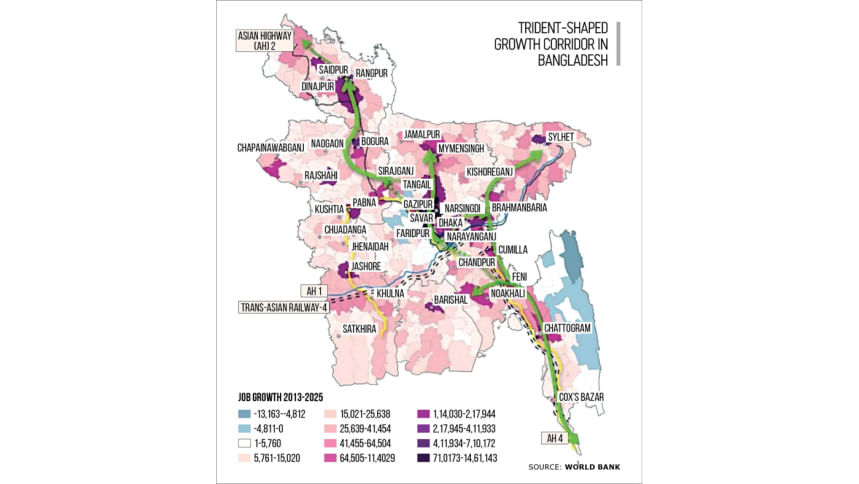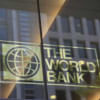World Bank maps ‘trident-shaped’ growth corridor in Bangladesh

- Dhaka, Chattogram dominate Bangladesh's job growth
- Rangpur emerges, forming trident-shaped corridor
- East-west divide deepens regional job disparity
- World Bank urges stronger spatial planning
Bangladesh's industrial and job growth has increasingly concentrated around Dhaka and Chattogram and, more recently, in the Rangpur city corporation area, forming a trident-shaped growth corridor, said a new World Bank (WB) study.
"This polarisation trend is also evident in nighttime lights (NTL) satellite imagery," said the WB in a special focus on a new urbanisation pathway to boost job growth in Bangladesh in its Bangladesh Development Update released on Tuesday.
NTL value is highest and grows fastest in the Dhaka metropolitan region and Chattogram region. More broadly, stronger NTL growth has occurred in the major regional cities with a population of more than 200,000, as well as the neighbouring highway areas linking these cities, it added.
The WB report said that over the past two decades, Bangladesh has undergone significant shifts in the geography of employment, population growth, and infrastructure development, driven largely by the rapid expansion of its manufacturing sector, particularly the garment and textile industry.
Such dynamism has been shaped mainly through "bottom-up" market forces, most of which have taken place in the absence of appropriate planning, sufficient infrastructure, and basic service support.
"This somewhat chaotic and unregulated development and industrialisation process, at least at the earlier stage, has contributed to the overall growth story of Bangladesh as market demand was able to be accommodated quickly and responsively," it said.
However, rapid expansion in the Dhaka-Chattogram corridor has created congestion pressures. As such, industrial development has continuously suburbanised to the "periphery areas" of key growth engines, administratively classified as rural areas, with even less infrastructure and planning support than the urban centres, it added.
The WB said industries have grown faster when located in areas with access to major urban labour markets and the Chattogram port for imports and exports.
The fastest job growth has occurred along the Dhaka-Chattogram corridor, which hosts most large, high-productivity manufacturing jobs, particularly in garments and textiles.
Recently, this growth has extended south toward Cox's Bazar and north toward Sylhet, Mymensingh, and Rangpur, forming a trident-shaped growth pattern, though on a smaller scale, it added.
The WB report said several municipalities within and beyond the main growth corridor, such as Madhabdi-Narsingdi, Brahmanbaria, and Noakhali, have gained importance due to their strategic locations.
Narsingdi and Madhabdi, situated east of Dhaka near the Meghna River, have attracted many textile industries in the past decade, including foreign investments.
"Brahmanbaria also has experienced robust growth due to its important nodal location in connecting Sylhet with Chattogram, without having to pass through the Dhaka area."
Along the Dhaka-Chattogram corridor, Noakhali has seen rapid population and job growth, reflecting spillover effects from the main highway.
The report cited the Export Processing Zones (EPZs) and added that EPZs near Dhaka, Chattogram, and the corridor have become major employment hubs. The remote zones, such as Mongla in Bagerhat and Uttara in Nilphamari, have struggled to attract investors despite available land and incentives.
The WB study terms the industrialisation and job creation as an "east-west divide" and said the divide was considered to have caused "regional disparity and welfare gaps, which, although being reduced in recent years, is also evident from the spatial job growth pattern."
Job growth areas are highly interconnected, it said, citing the major corridor from Cox's Bazar through Chattogram, Feni, Comilla, Brahmanbaria, Narsingdi, Naranganj, Dhaka city corporation, Gazipur, Mymensingh, Savar, Sirajganj, Bogura, and up to the Rangpur border adjacent to India.
"In the southwestern region, however, job growth is limited to a few areas within a patchy pattern," it said. "These development and growth patterns have further intensified regional disparity and shaped significantly distinct regional characteristics of job growth."
The report identified a lack of agglomeration economies, when firms and people locate near each other, in Bangladesh, due to the weak growth of secondary cities such as district headquarters and larger municipalities.
The WB said about ten of the 55 district headquarters have seen notable job growth and added that these areas have played a limited role as employment centres, struggling to sustain jobs outside major regional growth poles.
It said there is a mismatch between areas of actual job growth and the focus of urban development policies and investment.
The WB terms the mismatch as "a major policy blind spot".
"This development trend and policy bottleneck is further undermined by institutional binding constraints, including weak planning, inefficient resource allocation, insufficient devolution and deconcentration, and weak local capacity."
Policy makers need to rethink their spatial approach to urbanisation, adopting a new strategy that focuses on enhancing efficiency in planning and the utilisation of fiscal resources, and strengthening and empowering urban local governments, it said.
The WB suggested strengthening spatially-oriented planning and investment that responds to the differentiated needs of the distinct regions in Bangladesh. It recommended empowering urban local governments to play a more prominent role by enhancing their financial and technical capacities.
"Moving forward, Bangladesh's future success depends on not only sustained growth and the quality of jobs but also how more and better jobs can benefit people's lives, particularly the youth and women in Bangladesh."

 For all latest news, follow The Daily Star's Google News channel.
For all latest news, follow The Daily Star's Google News channel. 






Comments